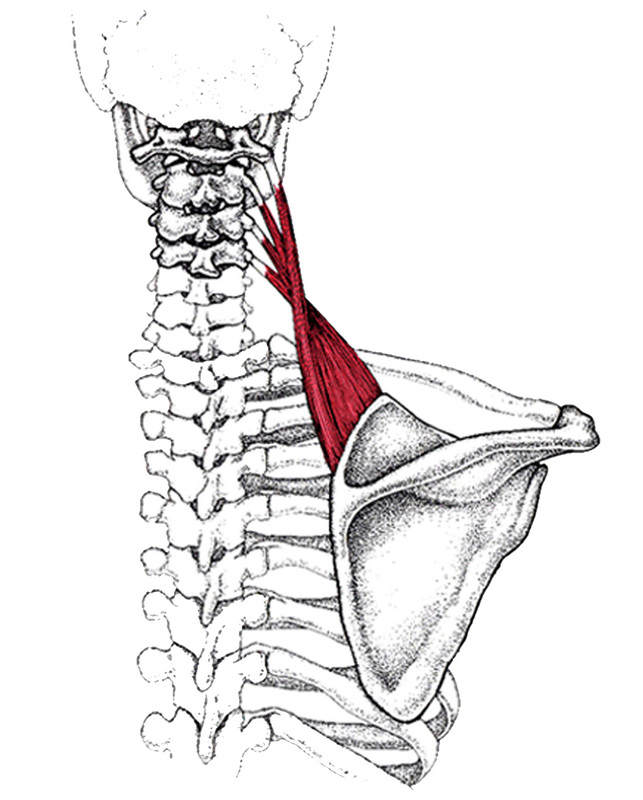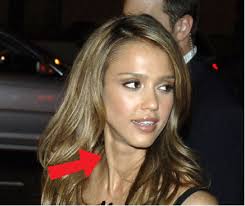 If you are reading this, you are most likely sitting at a computer. Now check in with your body, is there a bit of an ache in your upper neck or a knot at your shoulder blade that never seems to go away? Meet, Levator Scapula! This muscle is only about two fingers wide but causes worlds of pain for a lot of people. It is tucked under the Trapezius, that big diamond shaped muscle on the back. It connects to the upper portion of the shoulder blade and then separates into individual sections that attach to four of the cervical vertebrae. To make things even more interesting, there is a large group of nerves, the brachial plexus that intertwine among the muscle sections. When the muscle gets tight these nerves get pinched sending pain down the arm and into the hand. These nerves also get impinged if you are always looking down at your cell phone or read with your chin on your chest, but that involves the Scalenes which is another story… The Levator Scapula is a popular spot for tension to hang out and cause a lot of trouble. The muscle is used for several things; lifting the shoulder blade toward the ears, moving the shoulder blade down, moving the head laterally side to side, rotating the head and neck and extending the head and neck. Little kids use these muscles all the time when you ask them why they did something and they look at you and shrug while saying, “I don’t know”. When sitting at the desk and using the computer most people have a tendency to shrug the shoulders up, this tenses the Levator Scapula which contributes to that nasty knot that you feel in the upper shoulders. To decrease and help prevent problems with this little trouble maker here are some tips: - Stay hydrated. Always drink plenty of water to keep muscles working fluidly. - Put computer monitors at eye level. - When working on a laptop, make sure your chin is in neutral position. - Monitor body position through out the day, especially when under addition stress. Think of the bones stacked on top of each other and arms should hang comfortably from the sides of the body, not up next to your ears. - Try to avoid having the head turned in any one direction for too long. - Take breaks to stretch and rotate and move head, neck and shoulders throughout the day to keep muscles more relaxed and circulation moving. - GET A MASSAGE!  The Sternocleidomastoid, or SCM, is a muscle that connects the skull to the collar bone. If you rotate your head from side to side, you will see that it attaches from behind the ear and runs down the front of the neck and attaches to the clavicle at the front of your neck. This muscle is beefy and strong and keeps pretty busy, so it is no wonder that it is usually tight and causes problems. Many massage clients will put their hand on the back of the neck when complaining about tight neck muscles or tension headache, not realizing that the real culprit is in plain sight, in the front of the neck. Let’s talk about all the things this over-achieving muscle does; moves the head laterally (like holding a phone on your shoulder), rotates the head from side to side , flexes the neck (looking down at your cell phone) and assists with inhalation by helping to lift the rib cage (stress contributes to tension of rib cage). Basically, if you are moving your head, this muscle is being used. So those of you that use phones; hand sets and cell phones, read or work on laptops in bed or do work that requires you to look down a lot are the ones that will come in complaining about your sore neck and sometimes a headache. Unfortunately most massage therapists don’t work this area because it is painful for the client and is awkward to do. Most of the time, the attention is on the muscles at the back of the neck, but when you get off the table, the pain will come back quickly if the real problem isn’t addressed. Here are some ways to prevent and cut down on problems with your neck… When the back of your neck is tight or painful, take a moment and check in with your body posture. What is the distance between your chin and chest? Have you been looking one direction or the other for a period of time such as in conversation or looking out a car window? By keeping your chin the same distance from your chest as it would be if you were lying down, you will help prevent shortening of the SCM. This will help keep muscles on the back of the neck from being pulled, over-worked and unhappy. A simple stretch for the SCM is to lie on your bed and let your head hang over the edge but keep the neck supported by the edge of the bed. Close your mouth to increase the stretch, and turn your head from side to side, slowly. After a day at the office, this will help keep the SCM loose and the neck will be more comfortable. The Sternocleidomastoid is a muscle that is used all the time. By being aware of how you are moving your head, monitoring stress and tension levels and using proper body mechanics, you can help prevent this muscle from being a pain in the neck! |
Archives
January 2023
|
 RSS Feed
RSS Feed